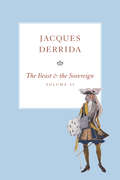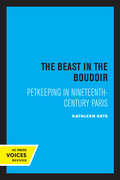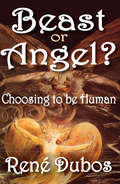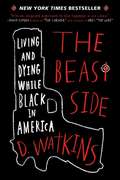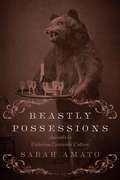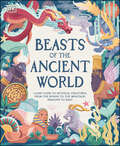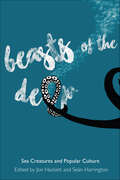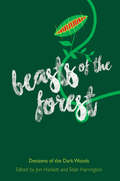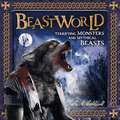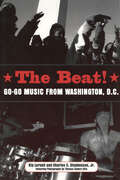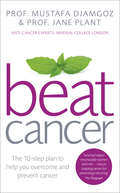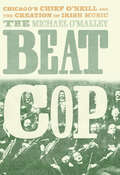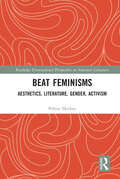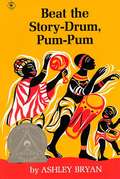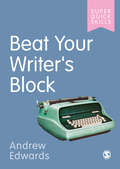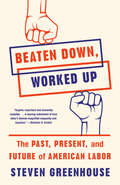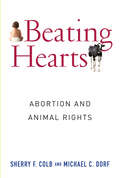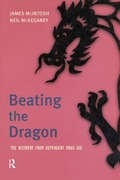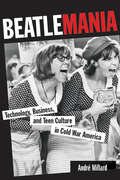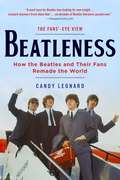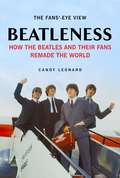- Table View
- List View
The Beast and the Sovereign, Volume II
by Jacques DerridaFollowing on from The Beast and the Sovereign, Volume I, this book extends Jacques Derrida's exploration of the connections between animality and sovereignty. In this second year of the seminar, originally presented in 2002-2003 as the last course he would give before his death, Derrida focuses on two markedly different texts: Heidegger's 1929-1930 course The Fundamental Concepts of Metaphysics, and Daniel Defoe's Robinson Crusoe. As he moves back and forth between the two works, Derrida pursuesthe relations between solitude, insularity, world, violence, boredom and death as they supposedly affect humans and animals in different ways. Hitherto unnoticed or underappreciated aspects of Robinson Crusoe are brought out in strikingly original readings of questions such as Crusoe's belief in ghosts, his learning to pray, his parrot Poll, and his reinvention of the wheel. Crusoe's terror of being buried alive or swallowed alive by beasts or cannibals gives rise to a rich and provocative reflection on death, burial, and cremation, in part provoked by a meditation on the death of Derrida's friend Maurice Blanchot. Throughout, these readings are juxtaposed with interpretations of Heidegger's concepts of world and finitude to produce a distinctively Derridean account that will continue to surprise his readers.
The Beast in the Boudoir: Petkeeping in Nineteenth-Century Paris
by Kathleen KeteKathleen Kete's wise and witty examination of petkeeping in nineteenth-century Paris provides a unique window through which to view the lives of ordinary French people. She demonstrates how that cliché of modern life, the family dog, reveals the tensions that modernity created for the Parisian bourgeoisie. Kete's study draws on a range of literary and archival sources, from dog-care books to veterinarians's records to Dumas's musings on his cat. The fad for aquariums, attitudes toward vivisection, the dread of rabies, the development of dog breeding—all are shown to reflect the ways middle-class people thought about their lives. Petkeeping, says Kete, was a way to imagine a better, more manageable version of the world—it relieved the pressures of contemporary life and improvised solutions to the intractable mesh that was post-Enlightenment France. The faithful, affectionate family dog became a counterpoint to the isolation of individualism and lack of community in urban life. By century's end, however, animals no longer represented the human condition with such potency, and even the irascible, autonomous cat had been rehabilitated into a creature of fidelity and affection. Full of fascinating details, this innovative book will contribute to the way we understand culture and the creation of class. This title is part of UC Press's Voices Revived program, which commemorates University of California Press’s mission to seek out and cultivate the brightest minds and give them voice, reach, and impact. Drawing on a backlist dating to 1893, Voices Revived makes high-quality, peer-reviewed scholarship accessible once again using print-on-demand technology. This title was originally published in 1994.
Beast or Angel?: Choosing to be Human
by Rene DubosThe world of things is different now from what it was half a century ago, but Rene Dubos doubts that there have been basic changes in life itself, in those attitudes and activities, needs, and yearning, that are the most important for happiness and suffering, for hope and despair the differences between humanity and animality. Sophisticated and civilized as we may be, we have retained from our distant ancestors the ability to derive profound satisfaction from the small happenings of daily life.Beast or Angel? attempts to trace the origins of needs and yearnings that have always been those of humankind everywhere and always. In this search, Dubos expresses the same concerns and uses the same words when speaking of the past, the present, or the future the reason being that the biological and psychological characteristics of humankind have remained essentially the same for at least fifty millennia.We are human to the extent that we live according to certain principles which have a human quality. This quality has emerged and continues to emerge from the choices that we make throughout our individual lives and that humankind has made from the beginning of its existence. To be human is to be able and willing to choose among the options that are offered to the human species by the natural order of things. This book examines human species, not only on the basis of the biological and psychological attributes it shares with animal species, but more by identifying its choices throughout pre-history and history.
The Beast Side: Living and Dying While Black in America
by David Talbot D. WatkinsA New York Times Best Seller!To many, the past 8 years under President Obama were meant to usher in a new post-racial American political era, dissolving the divisions of the past. However, when seventeen-year-old Trayvon Martin was shot by a wannabe cop in Florida; and then Ferguson, Missouri, happened; and then South Carolina hit the headlines; and then Baltimore blew up, it was hard to find any evidence of a new post-racial order. Suddenly the entire country seemed to be awakened to a stark fact: African American men are in danger in America. This has only become clearer as groups like Black Lives Matter continue to draw attention to this reality daily not only online but also in the streets of our nation's embattled cities.Now one of our country's quintessential urban war zones is brought powerfully to life by a rising young literary talent, D. Watkins. The author fought his way up on the eastside (the "beastside") of Baltimore, Maryland-or "Bodymore, Murderland," as his friends call it. He writes openly and unapologetically about what it took to survive life on the streets while the casualties piled up around him, including his own brother. Watkins pushed drugs to pay his way through school, staying one step ahead of murderous business rivals and equally predatory lawmen. When black residents of Baltimore finally decided they had had enough-after the brutal killing of twenty-five-year-old Freddie Gray while in police custody-Watkins was on the streets as the city erupted. He writes about his bleeding city with the razor-sharp insights of someone who bleeds along with it. Here are true dispatches from the other side of America.In this new paperback edition, the author has also added new material responding to the rising tide of racial resentment and hate embodied by political figures like Donald Trump and Ted Cruz, and the impact this has had on issues of race in America. This book is essential reading for anyone trying to make sense of the chaos of our current political moment.
The Beast Side: Living (and Dying) While Black in America
by D. WatkinsTo many people in the Obama era, America finally succeeded in going beyond race, putting the divisions of the past behind us. And then 17-year-old Trayvon Martin was shot by a wannabe cop in Florida; and then Ferguson, Missouri happened; and then South Carolina hit the headlines; and then Baltimore blew upSuddenly the entire country seemed to be waking to a stark fact: African American men are an endangered species. Now the country s urban war zone is brought powerfully to life by a rising young literary talent, D. Watkins. The author fought his way up on the eastside (the beastside ) of Baltimore, Marylandor Bodymore, Murderland as his friends call it. He writes openly and unapologetically about what it took to survive life on the streets, while the casualties piled up around him, including his own brother. Watkins pushed drugs to pay his way through school, staying one step ahead of murderous business rivals and equally predatory lawmen. When black residents of Baltimore finally decided they had had enoughafter the brutal killing of 25-year-old Freddie Gray while in police custodyWatkins was on the streets when the city erupted. He writes about his bleeding city with the razor-sharp insights of someone who bleeds along with it. Here are true dispatches from the other side of Obama s America. "
Beastly Possessions
by Sarah AmatoIn Beastly Possessions, Sarah Amato chronicles the unusual ways in which Victorians of every social class brought animals into their daily lives. Captured, bred, exhibited, collected, and sold, ordinary pets and exotic creatures - as well as their representations - became commodities within Victorian Britain's flourishing consumer culture.As a pet, an animal could be a companion, a living parlour decoration, and proof of a household's social and moral status. In the zoo, it could become a public pet, an object of curiosity, a symbol of empire, or even a consumer mascot. Either kind of animal might be painted, photographed, or stuffed as a taxidermic specimen.Using evidence ranging from pet-keeping manuals and scientific treatises to novels, guidebooks, and ephemera, this fascinating, well-illustrated study opens a window into an underexplored aspect of life in Victorian Britain.
Beasts of the Ancient World: A Kids’ Guide to Mythical Creatures, from the Sphinx to the Minotaur, Dragons to Baku
by Marchella WardUncover tales of ancient beasts, in this beautiful anthology of mythologiesThis book introduces children to the thrilling mythological beasts from ancient civilizations. Discover 23 stories accompanied by beautiful, colorful illustrations. Through the incredible storytelling you can learn about fantastic creatures such as the Japanese Baku, which had the power to devour nightmares, the wise Sphinx, and the fearsome Minotaur who went head-to-head with Theseus in Greek mythology. Featured pages highlight amazing real-life photos of objects, showing how each beast was represented in art. A perfect, global introduction to the most fascinating stories about legendary creatures from ancient history.
Beasts of the Deep: Sea Creatures and Popular Culture
by Jon Hackett and Seán HarringtonBeasts of the Deep: Sea Creatures and Popular Culture offers its readers an in-depth and interdisciplinary engagement with the sea and its monstrous inhabitants; through critical readings of folklore, weird fiction, film, music, radio and digital games. Within the text there are a multitude of convergent critical perspectives used to engage and explore fictional and real monsters of the sea in media and folklore. The collection features chapters from a variety of academic perspectives; post- modernism, psychoanalysis, industrial-organisational analysis, fandom studies, sociology and philosophy are featured. Under examination are a wide range of narratives and media forms that represent, reimagine and create the Kraken, mermaids, giant sharks, sea draugrs and even the weird creatures of H.P. Lovecraft.Beasts of the Deep offers an expansive study of our sea-born fears and anxieties, that are crystallised in a variety of monstrous forms. Repeatedly the chapters in the collection encounter the contemporary relevance of our fears of the sea and its inhabitants – through the dehumanising media depictions of refugees in the Mediterranean to the encroaching ecological disasters of global warming, pollution and the threat of mass marine extinction.
Beasts of the Forest: Denizens of the Dark Woods
by Jon Hackett and Seán HarringtonAn interdisciplinary engagement with the forest and its monsters through critical readings of folklore, fiction, film, music video and animation.Within the text there are a multitude of convergent critical perspectives used to engage and explore fictional and real monsters of the forest in media and folklore. The collection features chapters from a variety of academic perspectives: film and media studies, cultural studies, queer theory, Tolkien studies, mythology and popular music are featured. Under examination are a wide range of narratives and media forms that represent, reimagine and create the werewolves, witches and weird apparitions that inhabit the forest, along with the forest as a monstrous entity in itself.Whether they be our shelter and safe-haven or the domain of malevolent spirits and sprites, forests have the capacity to horrify and threaten those that venture into them without permission. Human interference has continually threatened forests across the world, yet this threat is reversed in myth, folklore and more recent cultural forms. This collection ranges widely to analyze how forests figure in contemporary culture, as well as the wider contexts in which such representations are inserted.
Beastworld: Terrifying Monsters and Mythical Beasts
by S.A. CaldwellStep into a world of fascinating, mystical and terrifying beasts from around the globe. Join fearless beast hunter S.A. Caldwell as she tracks down the most elusive creatures from ancient myths, strange sightings and folklore. Follow her to a Gorgon's lair, track down the yeti in the Himalayas, find out what lies beneath the myth of the bogeyman and discover the Hydra's immortal head!
The Beat: Go-Go Music from Washington, D.C. (American Made Music Series)
by Kip Lornell Charles C. Stephenson Jr.The Beat! was the first book to explore the musical, social, and cultural phenomenon of go-go music. In this edition, updated by a substantial chapter on the current scene, authors Kip Lornell and Charles C. Stephenson, Jr., place go-go within black popular music made since the middle 1970s—a period during which hip-hop has predominated. This styling reflects the District's African American heritage. Its super-charged drumming and vocal combinations of hip-hop, funk, and soul evolved and still thrive on the streets of Washington, DC, and in neighboring Prince George's County, making it the most geographically compact form of popular music. Go-go—the only musical form indigenous to Washington, DC—features a highly syncopated, nonstop beat and vocals that are spoken as well as sung. The book chronicles its development and ongoing popularity, focusing on many of its key figures and institutions, including established acts such as Chuck Brown (the Godfather of Go-Go), Experience Unlimited, Rare Essence, and Trouble Funk; well-known DJs, managers, and promoters; and filmmakers who have incorporated it into their work. The Beat! provides longtime fans and those who study American musical forms a definitive look at the music and its makers.
Beat Cancer: How to Regain Control of Your Health and Your Life
by Jane Plant CBE Mustafa DjamgozIf you or someone you love has been diagnosed with cancer, you want to do everything possible to beat the disease. But with so much conflicting advice and so many options available, how do you decide on the best treatment plan for you?In this major new book, Professor Jane Plant and Professor Mustafa Djamgoz present a clear and scientifically sound 10-step programme to help you beat cancer. At a time when you may be feeling helpless and confused, this book provides the essential guidance you need to take control of your life and regain your health with targeted advice for specific cancers.Included in the 10-step plan:· Inform yourself: understand what cancer is, what causes it and how to avoid carcinogens· Choosing the right treatment: evidence-based advice on conventional and complementary therapies, including chemotherapy, radiotherapy, surgery and medication· Change your lifestyle: guidance on diet, exercise, reducing stress, relationships and other lifestyle factors that have a proven link with cancerBeat Cancer will help you prevent cancer, tackle your diagnosis and stay in remission.
The Beat Cop: Chicago's Chief O'Neill and the Creation of Irish Music
by Michael O'MalleyThe remarkable story of how modern Irish music was shaped and spread through the brash efforts of a Chicago police chief.Irish music as we know it today was invented not just in the cobbled lanes of Dublin or the green fields of County Kerry, but also in the burgeoning metropolis of early-twentieth-century Chicago. The genre’s history combines a long folk tradition with the curatorial quirks of a single person: Francis O’Neill, a larger-than-life Chicago police chief and an Irish immigrant with a fervent interest in his home country’s music.Michael O’Malley’s The Beat Cop tells the story of this singular figure, from his birth in Ireland in 1865 to his rough-and-tumble early life in the United States. By 1901, O’Neill had worked his way up to become Chicago’s chief of police, where he developed new methods of tracking criminals and recording their identities. At the same time, he also obsessively tracked and recorded the music he heard from local Irish immigrants, enforcing a strict view of what he felt was and wasn’t authentic. Chief O’Neill’s police work and his musical work were flip sides of the same coin, and O’Malley delves deep into how this brash immigrant harnessed his connections and policing skills to become the foremost shaper of how Americans see, and hear, the music of Ireland.
Beat Feminisms: Aesthetics, Literature, Gender, Activism (Routledge Transnational Perspectives on American Literature)
by Polina MackayThis is the first book-length study to read women of the Beat Generation as feminist writers. The book focuses on one author from each of the three generations that comprise the groups of female writers associated with the Beats – Diane di Prima, ruth weiss and Anne Waldman – as well as on experimental and multimedia artists, such as Laurie Anderson and Kathy Acker, who have not been read through the prism of Beat feminism before. Beat Feminisms argues that these writers’ feminism evolved over time, but retained a focus on intertextuality, on visions of transformation, on revisions of patriarchal discourses, on gender and on interventionist poetics within the context of activism. The book shows how these Beat feminisms counteract the ways in which women have been undermined, possessed or silenced.
Beat the Story Drum, Pum-Pum
by Ashley BryanFive traditional Nigerian tales including "Hen and Frog," "Why Bush Cow and Elephant are Bad Friends," "The Husband Who Counted the Spoonfuls," "Why Frog and Snake Never Play Together," and "How Animals Got Their Tails."<P><P>Winner of the Coretta Scott King Medal
Beat Your Writer's Block (Super Quick Skills)
by Andrew EdwardsFinding it difficult to begin writing? This book gives you the knowledge and tools you need to be able to understand the root of your writing anxiety, overcome your writer's block and write with ease. Understand and overcome writing anxiety Implement techniques such as clustering, mind mapping, and journaling Be confident in your writing. Super Quick Skills provide the essential building blocks you need to succeed at university - fast. Packed with practical, positive advice on core academic and life skills, you&’ll discover focused tips and strategies to use straight away. Whether it&’s writing great essays, understanding referencing or managing your wellbeing, find out how to build good habits and progress your skills throughout your studies. Learn core skills quickly Apply right away and see results Succeed in your studies and life. Super Quick Skills give you the foundations you need to confidently navigate the ups and downs of university life.
Beat Your Writer's Block (Super Quick Skills)
by Andrew EdwardsFinding it difficult to begin writing? This book gives you the knowledge and tools you need to be able to understand the root of your writing anxiety, overcome your writer's block and write with ease. Understand and overcome writing anxiety Implement techniques such as clustering, mind mapping, and journaling Be confident in your writing. Super Quick Skills provide the essential building blocks you need to succeed at university - fast. Packed with practical, positive advice on core academic and life skills, you&’ll discover focused tips and strategies to use straight away. Whether it&’s writing great essays, understanding referencing or managing your wellbeing, find out how to build good habits and progress your skills throughout your studies. Learn core skills quickly Apply right away and see results Succeed in your studies and life. Super Quick Skills give you the foundations you need to confidently navigate the ups and downs of university life.
Beaten Down, Worked Up: The Past, Present, and Future of American Labor
by Steven GreenhouseFrom the longtime New York Times labor correspondent, an in-depth look at working men and women in America, the challenges they face, and how they can be re-empoweredIn an era when corporate profits have soared while wages have flatlined, millions of Americans are searching for ways to improve their lives, and they're often turning to labor unions and worker action, whether #RedforEd teachers' strikes or the Fight for $15. Wage stagnation, low-wage work, and blighted blue-collar communities have become an all-too-common part of modern-day America, and behind these trends is a little-discussed problem: the decades-long decline in worker power. Steven Greenhouse sees this decline reflected in some of the most pressing problems facing our nation today, including income inequality, declining social mobility, the gender pay gap, and the concentration of political power in the hands of the wealthy. He rebuts the often-stated view that labor unions are outmoded--or even harmful--by recounting some of labor's victories, and the efforts of several of today's most innovative and successful worker groups. He shows us the modern labor landscape through the stories of dozens of American workers, from G.M. workers to Uber drivers, and we see how unions historically have empowered--and lifted--the most marginalized, including young women garment workers in New York in 1909, black sanitation workers in Memphis in 1968, and hotel housekeepers today. Greenhouse proposes concrete, feasible ways in which workers' collective power can be--and is being--rekindled and reimagined in the twenty-first century.
Beating Hearts: Abortion and Animal Rights (Critical Perspectives on Animals: Theory, Culture, Science, and Law)
by Sherry Colb Michael DorfHow can someone who condemns hunting, animal farming, and animal experimentation also favor legal abortion, which is the deliberate destruction of a human fetus? The authors of Beating Hearts aim to reconcile this apparent conflict and examine the surprisingly similar strategic and tactical questions faced by activists in the pro-life and animal rights movements. Beating Hearts maintains that sentience, or the ability to have subjective experiences, grounds a being's entitlement to moral concern. The authors argue that nearly all human exploitation of animals is unjustified. Early abortions do not contradict the sentience principle because they precede fetal sentience, and Beating Hearts explains why the mere potential for sentience does not create moral entitlements. Late abortions do raise serious moral questions, but forcing a woman to carry a child to term is problematic as a form of gender-based exploitation. These ethical explorations lead to a wider discussion of the strategies deployed by the pro-life and animal rights movements. Should legal reforms precede or follow attitudinal changes? Do gory images win over or alienate supporters? Is violence ever principled? By probing the connections between debates about abortion and animal rights, Beating Hearts uses each highly contested set of questions to shed light on the other.
Beating the Dragon: The Recovery from Dependent Drug Use
by James McIntoshSuitable for 2nd and 3rd year students taking courses on drug use/misuse principally in departments such as Sociology, Law, Cultural and Media Studies, and Psychology. Also particularly relevant for students taking courses leading to a profession, such as nurses and social workers. The use of illegal drugs is widespread in many societies. Within many western societies particular concern has been focused on the nature and extent of illegal drug use amongst young people. In much of the media coverage an impression is often conveyed that the use of illegal drugs other than cannabis is a one way street leading inevitably to addiction, destitution, family breakdown and death. This impression fails to grasp the fact that most drug users do not become addicts and most addicts do not die. The perception of addiction as a fixed end point characterised by personal and social dissolution fails to recognise that many dependent drug users, even after a period of prolonged dependent drug use, nevertheless still manage to overcome their dependence upon illegal drugs. This process of recovery, either with or without the assistance of helping agencies, has been variously described by researchers, drug counsellors, clinicians and others.
Beatlemania: Technology, Business, and Teen Culture in Cold War America (Johns Hopkins Introductory Studies in the History of Technology)
by André MillardThe fame, talent, and success of the Beatles need no introduction. Nor does the world need another book exploring the band's skill and its influence on music and society in the United States, Britain, and the rest of the world. André Millard instead studies the Beatlemania phenomenon from an original perspective—the relationship among the music business, recording technologies, and teens and young adult culture of the era. Millard argues that, despite the Beatles’ indisputable skill, they would not have attained the global recognition and been as influential without the convergence of significant developments in the way music was produced, recorded, sold, and consumed. As the Second Industrial Revolution hit full swing and baby boomers came of age, the reel-to-reel recorder and other technological advances sped the evolution of the music business. Musicians, recording studios and record labels, and music fans used and interacted with music-making and -playing technology in new ways. Higher quality machines made listening to records and the radio an experience that one could easily share with others, even if they weren’t in the same physical space. At the same time, an increase in cross-Atlantic commerce—especially of entertainment products—led to a freer exchange of ideas and styles of expression, notably among the middle and lower classes in the U.S. and the UK. At that point, Millard argues, the Beatles rode their remarkable musicianship and cultural savvy to an unprecedented bond with their fans—and spawned Beatlemania. Refreshing and insightful, Beatlemania offers a deeper understanding the days of the Fab Four and the band’s long-term effects on the business and culture of pop music.
Beatlemania: Technology, Business, and Teen Culture in Cold War America (Johns Hopkins Introductory Studies In The History Of Science)
by André MillardThis look at how changes in the music industry made the Fab Four phenomenon possible “presents a different interpretation of a much-studied topic” (Essays in Economic and Business History).In this unique study, André Millard argues that, despite the Beatles’ indisputable skill, they would not have attained the same global recognition or been as influential without the convergence of significant developments in the way music was produced, recorded, sold, and consumed. As the Second Industrial Revolution hit full swing and baby boomers came of age, the reel-to-reel recorder and other technological advances sped the evolution of the music business. Musicians, recording studios and record labels, and music fans used and interacted with music-making and -playing technology in new ways. Higher quality machines made listening to records and the radio an experience that one could easily share with others, even if they weren’t in the same physical space. At the same time, an increase in cross-Atlantic commerce—especially of entertainment products—led to a freer exchange of ideas and styles of expression, notably among the middle and lower classes in the U.S. and the UK. At that point, Millard argues, the Beatles rode their remarkable musicianship and cultural savvy to an unprecedented bond with their fans—and spawned Beatlemania.Lively and insightful, Beatlemania offers a deeper understanding the days of the Fab Four and the band’s long-term effects on the business and culture of pop music.
Beatleness: How the Beatles and Their Fans Remade the World
by Candy Leonard"A must-have for Beatles fans looking for new insight . . . Leonard uncovers fresh ideas [that] . . . six decades of Beatles literature passed over. —The SpectrumPart generational memoir and part cultural history of the sixties, Beatleness is the first book to tell the story of the Beatles and their impact on America from the fans’ perspective. When the Beatles arrived in the United States on February 7, 1964, they immediately became a constant, compelling presence in fans’ lives. For the next six years, the band presented a nonstop deluge of steadily evolving sounds, ideas, and images that transformed the childhood and adolescence of millions of baby boomers and nurtured a relationship unique in history. Exploring that relationship against the backdrop of the sexual revolution, political assassinations, the Vietnam War, and other events, Beatleness examines critically the often-heard assertion that the Beatles ?changed everything” and shows how—through the interplay between the group, the fans, and the culture?that change came about.Beatleness incorporates hundreds of hours of in-depth fan interviews and includes many fan vignettes. Offering a fresh perspective and new insights on the Beatles phenomenon, it allows readers to experience—or re-experience—what it was like to be a young person during those transformative years.
Beatleness
by Candy LeonardThe Beatles arrived in the United States on February 7, 1964, and immediately became a constant, compelling presence in fans' lives. For the next six years, the band presented a nonstop deluge of sounds, words, images, and ideas, transforming the childhood and adolescence of millions of baby boomers.Beatleness explains how the band became a source of emotional, intellectual, aesthetic, and spiritual nurturance in fans' lives, creating a relationship that was historically unique. Looking at that relationship against the backdrop of the sexual revolution, the Vietnam War, political assassinations, and other events of those tumultuous years, the book examines critically the often-heard assertion that the Beatles "changed everything" and shows how-through the interplay between the group, the fans, and the culture-that change came about.A generational memoir and cultural history based on hundreds of hours of in-depth interviews with first-generation fans, Beatleness allows readers to experience-or re-experience-what it was like to be a young person during those eventful and transformative years. Its fresh approach offers many new insights into the entire Beatle phenomenon and explains why the group still means so much to so many.
